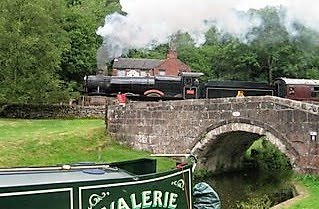This block of old canal warehouses is just about all that remains in the basin of a very busy industrial scene. I was always curious as to why the building carried on past the corner of the basin.
The building through the gap in the distance is part of the hospital but has an interesting history that surfaced during research of this post. Will blog it soon.
As you can see in this shot it`s not the floating walkway that gives this impression the building does move away from the canal edge. The other warehouse doors make easy work of loading/unloading of boats but the far left one always looked wrong to me.
My fascination with the Grand Junction Water Co. led me to find this map. As you can see in the top left there is an arm at this point in the basin. This led to a builders merchants The other things of interest are the reservoirs made originally for supplying the canal in case of water shortages. In 1811 the Grand Junction Canal Co. having an excess of water decided to go into the water supply business to properties in Paddington. Yep it was canal water they were supplying. It did lay in the reservoirs and became clear but was far from healthy so in 1820 they started taking water from the River Thames at Chelsea quite near a sewage outlet. That went on until in 1835 they moved to Kew, now the steam museum, and pumped water back 5 miles to the Paddington reservoirs through a 30" pipe. In 1855 after it became illegal to take water from the tidal part of the river they moved to Hampton and still pumped water via Kew to Paddington.
Notice the street name below the reservoirs, Grand Junction Street, now Sussex gardens. Further down the page is a link to an 1817 map and you can see the canal company was here all alone giving them no opposition to name things as they wish.
The south reservoir is here at Norfolk square.
The Lower reservoir is at Talbot square both of these are protected from development by an act of parliament granted when they were first built.
The North reservoir is here in London street and has been built on. All three were sold 1842-1851 and this site was shown on ordnance survey maps of 1872 (click 1872) as being part of St Mary`s hospital. The map also shows this side street as being called Amber Mews and Francis Mews running down the other side of the building. Today they are Winsland street and W`mews.
The part to the right of picture is to this day still part of the hospital. The GJWC built in 1855 a larger reservoir in nearby Kensington. Just 50 years later and the GJWC became Metropolitan Water Board.Links for further reading HERE HERE
1817 map showing the basin, 2 of the reservoirs and the pumping station HERE







4 comments:
The two noted resevoirs are still extant as named ares or have they been built upon as grassed areas with perhaps a resevoir underneath?
Water from the Thames near a sewage outlet?
Yikes...and one wonders why the diseases that plagued London happened when they did.
It was wonderful to catch up with you yesterday - I feel for your frustration at being trapped in the Southeast and am keeping all digits crossed for an uncomplicated recovery and for a fine autumn cruise to make up for it....
You're in my thoughts, in the meantime I can only offer the pithy aphorism, picked up from the side of nb Armadillo - "nil illegitimus carborundum" - google will translate if necessary :-)
Sue, nb Indigo Dream
Hi Bryce
All the reservoirs were filled in. The two gardens shown are the filled in reservoirs that could not be built on because the act granted dictated they were not to be built on.
At least it gives 2 more places Londoners can sit away from the hustle and bustle of modern day living.
Les
Hi Sue
Love the Latin and don`t worry boating keeps me calm so they won`t win.
Les
Post a Comment